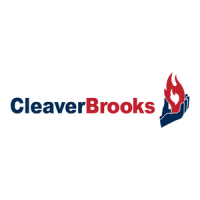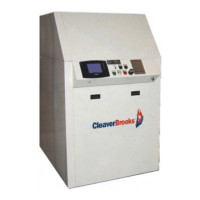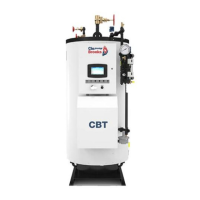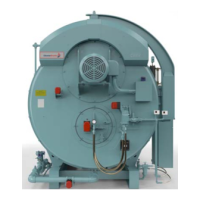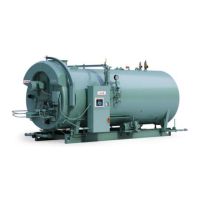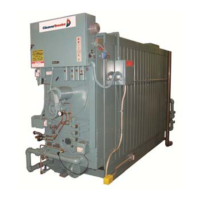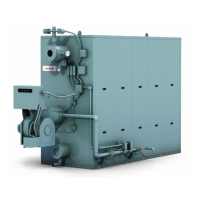CFC-E Installation Manual
Part No. 750-459 1-19
Table 1-9: Maximum flow rate through CFC-E boilers (U.S. flow rates)
Table 1-10: Maximum flow rate through CFC-E boilers (metric flow rates)
1.7 - Condensate Removal and Treatment
The condensate generated during normal boiler operation must be removed in accordance with local
codes and regulations. The condensate can be piped to a local treatment system or run into the optional
condensate treatment assembly. When piping condensate direct to drain, a trap (Figure 1-16) must be
installed on the condensate outlet to prevent discharge of flue gases from the boiler. When using the
combo tank/trap, a drain trap is included in the tank assembly and no external trap is required if cold
water is piped to the tank for make-up. If using either the combo tank/trap or tank with separate drain
trap, the boiler must be installed on a pad or on adjustable feet for proper condensate drainage.
The water trap must be filled with water prior to commissioning and checked or refilled at each required
maintenance interval.
Note: The condensate occurring during operation in both the boiler and the boiler stack has to be
neutralized and piped to a safe drain. The conditions for the discharge of condensates into
public drain systems are determined by the local authorities and municipalities.
Condensate leaving the boiler normally has a pH of 3-6. The responsible authority will inform you if a
higher pH value is required for condensate piped to drain. The CFC-E neutralization system contains a
natural compound which acts to increase the pH of the condensate flowing through it.
Note: To ensure compliance with regulations, it is important to contact the responsible authorities
prior to the planning and execution of the boiler installation. Condensate flow of 5 to 13.5
GPH can be expected depending on boiler size and return water temperature.
Temperature Differential (°F)
10 20 30 40 50 60 70 80 90 100 110 120
Size Flow Rate GPM
500 944731241916131210 9 9 8
750 141 71 47 35 28 24 20 18 16 14 13 12
10001889463473831272421191716
1500 283 141 94 71 57 47 40 35 31 28 26 24
2000 377 188 126 94 75 63 54 47 42 38 34 31
2500 471 235 157 118 94 78 67 59 52 47 43 39
3000 565 283 188 141 113 94 81 71 63 57 51 47
3500 659 330 220 165 132 110 94 82 73 66 60 55
4000 754 377 251 188 151 126 108 94 84 75 69 63
5000 942 471 314 235 188 157 135 118 105 94 86 78
6000 1130 565 377 283 226 188 161 141 126 113 103 94
Recommended flow rates relative to temperature drop so as not to exceed boiler output.
Based on 94% nominal effficiency and maximum firing capacity
Based on water only
Temperature Differential (°C)
6 1117222833394450566167
Size
Flow Rate m
3
/hr
500 21.4 10.7 7.1 5.3 4.3 3.6 3.1 2.7 2.4 2.1 1.9 1.8
750 32.1 16.0 10.7 8.0 6.4 5.3 4.6 4.0 3.6 3.2 2.9 2.7
1000 42.8 21.4 14.3 10.7 8.6 7.1 6.1 5.3 4.8 4.3 3.9 3.6
1500 64.1 32.1 21.4 16.0 12.8 10.7 9.2 8.0 7.1 6.4 5.8 5.3
2000 85.5 42.8 28.5 21.4 17.1 14.3 12.2 10.7 9.5 8.6 7.8 7.1
2500 106.9 53.5 35.6 26.7 21.4 17.8 15.3 13.4 11.9 10.7 9.7 8.9
3000 128.3 64.1 42.8 32.1 25.7 21.4 18.3 16.0 14.3 12.8 11.7 10.7
3500 149.7 74.8 49.9 37.4 29.9 24.9 21.4 18.7 16.6 15.0 13.6 12.5
4000 171.1 85.5 57.0 42.8 34.2 28.5 24.4 21.4 19.0 17.1 15.6 14.3
5000 213.8 106.9 71.3 53.5 42.8 35.6 30.5 26.7 23.8 21.4 19.4 17.8
6000 256.6 128.3 85.5 64.1 51.3 42.8 36.7 32.1 28.5 25.7 23.3 21.4
Recommended flow rates relative to temperature drop so as not to exceed boiler output.
Based on 94% nominal efficiency and maximum firing capacity
Based on water only
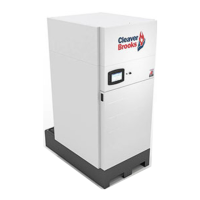
